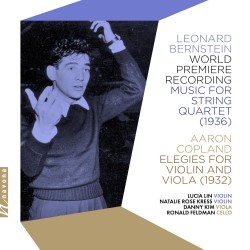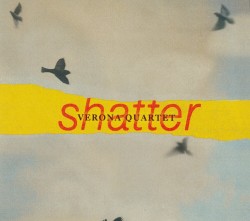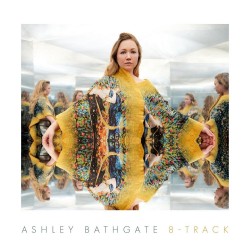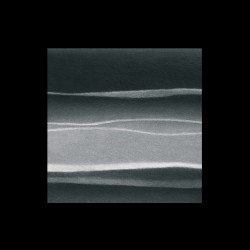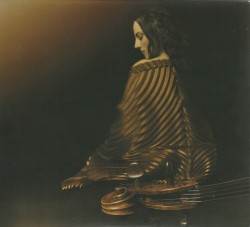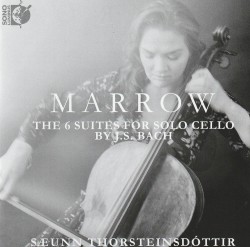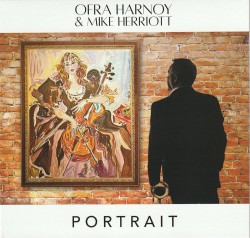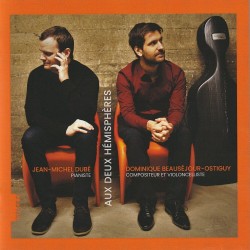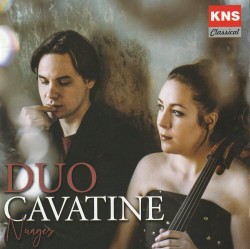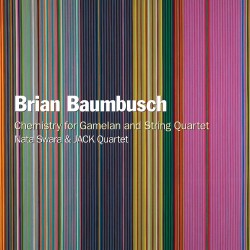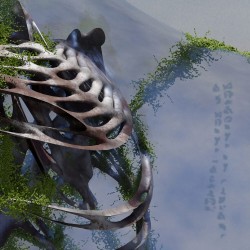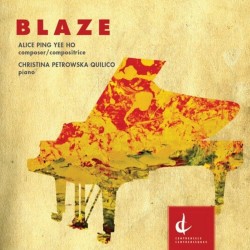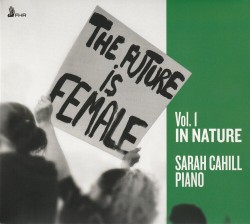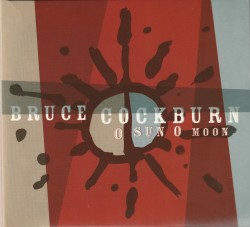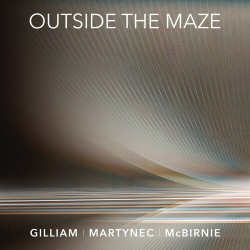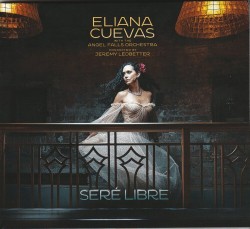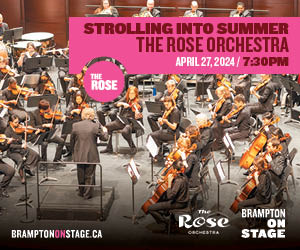Editor's Corner - October 2023
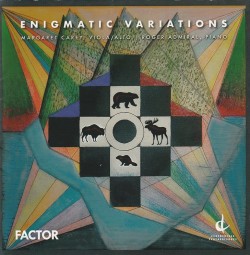 Enigmatic Variations consists of Canadian works performed by Calgary-based violist Margaret Carey and pianist Roger Admiral (Centrediscs CMCCD 32723 cmccanada.org/product-category/recordings/Centrediscs), opening with a piece by Malcolm Forsyth (1936-2011), Steps for Viola and Piano (1978). Traditionally melodic and idiomatically well-suited to the viola, the five movements are self-explanatory: Buoyant, Strange Light, Violent, Colours and Jocular, all played adeptly by Carey and Admiral. Milton Barnes (1931-2001) is featured on three tracks, Ballade for Solo Viola (1978) and Lament and Hymn Tune Pavane for Viola and Piano (1976). Barnes was a traditionalist by nature who was schooled in the 12-tone tradition but chose to avoid avant-garde idioms in favour of tonally based expression. The pieces included here, especially Ballade, are playfully rhythmic and melodic, at times reminiscent of childhood chants and songs.
Enigmatic Variations consists of Canadian works performed by Calgary-based violist Margaret Carey and pianist Roger Admiral (Centrediscs CMCCD 32723 cmccanada.org/product-category/recordings/Centrediscs), opening with a piece by Malcolm Forsyth (1936-2011), Steps for Viola and Piano (1978). Traditionally melodic and idiomatically well-suited to the viola, the five movements are self-explanatory: Buoyant, Strange Light, Violent, Colours and Jocular, all played adeptly by Carey and Admiral. Milton Barnes (1931-2001) is featured on three tracks, Ballade for Solo Viola (1978) and Lament and Hymn Tune Pavane for Viola and Piano (1976). Barnes was a traditionalist by nature who was schooled in the 12-tone tradition but chose to avoid avant-garde idioms in favour of tonally based expression. The pieces included here, especially Ballade, are playfully rhythmic and melodic, at times reminiscent of childhood chants and songs.
The title of the disc is taken from a 2021 work commissioned from Sean Clarke (b.1983). Clarke and Carey both studied at Mount Royal University Conservatory and the variations are inspired by the “virtuosity, playing and teaching style” of several of their teachers and colleagues, as well as a landscape drawing by Carey featuring Canadian flora and fauna imbedded in a Peruvian Inca Cross. Apart from occasional sharp outbursts, the variations remain as dark and enigmatic as the opening theme.
The most substantial work on this disc is the Viola Concerto Op.75 by one of the most prolific composers from Quebec, Jacques Hétu (1938-2010). Hétu composed 16 concerted works for most of the instruments usually found in an orchestra and several that are not, such as ondes Martinon, amplified guitars and marimba, plus a Rondo for cello and string orchestra and a Symphonie concertante for flute, oboe, clarinet, French horn, bassoon and strings. Not to mention four full symphonies. I don’t believe any Canadian composer has come close to this orchestral output. The Viola Concerto (performed here in a piano reduction) is in four contrasting movements. Although Admiral does a fine job with the piano accompaniment, the lush colours of Hétu’s original orchestration are a bit lost in the translation. Carey’s solo viola is however, here as throughout the disc, full and present with all the nuance we would expect.
In response to Carey’s request for a solo viola work, Stewart Grant (b.1948) transcribed his Two Poems – Breath of Life and The Rear View Mirror – originally composed for cello (2004). The disc concludes with a second 2021 commission, A Three Dog Night by the youngest composer represented here, Benjamin Sajo (b.1988). It’s another contemplative work, with the piano and dark-hued viola line perfectly balanced.
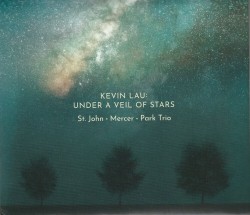 Another Canadian disc that has been in frequent rotation here this past month is Kevin Lau: Under a Veil of Stars featuring the St. John | Mercer | Park Trio (Leaf Music LM273 leaf-music.ca). Born in 1988, Lau is on track to give Jacques Hétu a run for the money in orchestral output. An almost ubiquitous figure on the GTHA music scene, Lau has served as composer-in-residence or affiliate composer with the Toronto, Mississauga and Niagara Symphony Orchestras, the Banff Centre and currently, the Manitoba Chamber Orchestra. In addition, his works have been performed by the National Arts Centre, Winnipeg Symphony, Vancouver Symphony, Hamilton Philharmonic and Tampa Bay Symphony Orchestras and the National Ballet of Canada, for which he has composed two major works. This release is devoted to his chamber music, including works for piano trio and subsets thereof.
Another Canadian disc that has been in frequent rotation here this past month is Kevin Lau: Under a Veil of Stars featuring the St. John | Mercer | Park Trio (Leaf Music LM273 leaf-music.ca). Born in 1988, Lau is on track to give Jacques Hétu a run for the money in orchestral output. An almost ubiquitous figure on the GTHA music scene, Lau has served as composer-in-residence or affiliate composer with the Toronto, Mississauga and Niagara Symphony Orchestras, the Banff Centre and currently, the Manitoba Chamber Orchestra. In addition, his works have been performed by the National Arts Centre, Winnipeg Symphony, Vancouver Symphony, Hamilton Philharmonic and Tampa Bay Symphony Orchestras and the National Ballet of Canada, for which he has composed two major works. This release is devoted to his chamber music, including works for piano trio and subsets thereof.
The extended title work is in three movements that are evocatively brought to life in the music: The Stars are Never Still; Land of Poison Trees and In that Shoreless Ocean. In his intimate program note Lau describes the impetus for the work, and how it changed with the death of the dedicatee, violinist Yehonatan Berick. Berick, along with his life partner cellist Rachel Mercer and pianist Angela Park comprised the AYR Trio who commissioned the work. Lau says the three movements depict a life cycle chronicling childhood, adulthood and old age. Renowned soloist and chamber musician Scott St. John has taken on the emotionally difficult task of replacing Berick in this trio’s configuration, not only in the trio works but also in Intuitions No.2, a violin and cello duo written for Berick and Mercer, and If Life Were a Mirror for violin and piano. This latter work comprises reflections on Arvo Pärt’s Spiegel im Spiegel (Mirror in the Mirror), in which we hear numerous echoes of familiar tunes from Bach and other icons, “musical artifacts that reflect one another like a hall of mirrors.” The former was composed as part of a set of pieces designed to be played by partners living in the same bubble during the pandemic lockdowns, and the latter was completed just before the COVID-19 outbreak.
The other trio works include two from 2007, Piano Trio No.1 and Timescape Variations, and A Simple Secret from 2019. The Dreamer for solo piano fills out the disc. Mercer and Park have worked together in various combinations over many years, including the piano quartet Ensemble Made in Canada, and their compatibility and intuitive partnership are on fine display here. St. John’s playing fits with these two like a glove, partly I’m sure due to Lau’s idiomatic and skilfully crafted music. A very satisfying release.
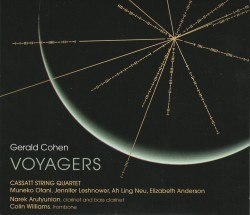 Gerald Cohen – Voyagers presents chamber music by this American composer performed by the Cassatt String Quartet with guest soloists Narek Arutyunian (clarinets) and trombonist Colin Williams (innova 090 innova.mu). Cohen (b.1960) is a Jewish cantor and professional baritone as well as a composer and his music often reflects his religious roots. Playing for Our Lives was written for the Cassatt for a 2012 concert devoted to music by composers interned at the Nazi concentration camp Terezin (Theresienstadt) near Prague. The quartet asked for a contemporary memorial and tribute to the musical life at that place, a transit camp on the road to Auschwitz and other death camps. The three movements draw on material related to Terezin: a Yiddish folk song Beryozkele (Little Birch Tree) which had also been set by Viktor Ullmann who perished in Auschwitz; a lullaby from Hans Krasa’s children’s opera Brundibar, composed and performed at Terezin; and Verdi’s Requiem, a piece championed at the camp by conductor Rafael Schachter, from which Cohen fashioned his Dies Irae (Day of Wrath). The music is at once angry, contemplative, full of angst, uplifting and haunting, ultimately ending in sublime quietude.
Gerald Cohen – Voyagers presents chamber music by this American composer performed by the Cassatt String Quartet with guest soloists Narek Arutyunian (clarinets) and trombonist Colin Williams (innova 090 innova.mu). Cohen (b.1960) is a Jewish cantor and professional baritone as well as a composer and his music often reflects his religious roots. Playing for Our Lives was written for the Cassatt for a 2012 concert devoted to music by composers interned at the Nazi concentration camp Terezin (Theresienstadt) near Prague. The quartet asked for a contemporary memorial and tribute to the musical life at that place, a transit camp on the road to Auschwitz and other death camps. The three movements draw on material related to Terezin: a Yiddish folk song Beryozkele (Little Birch Tree) which had also been set by Viktor Ullmann who perished in Auschwitz; a lullaby from Hans Krasa’s children’s opera Brundibar, composed and performed at Terezin; and Verdi’s Requiem, a piece championed at the camp by conductor Rafael Schachter, from which Cohen fashioned his Dies Irae (Day of Wrath). The music is at once angry, contemplative, full of angst, uplifting and haunting, ultimately ending in sublime quietude.
The title work for clarinet and string quartet is a tribute to the Voyager spacecraft, launched in 1977 and headed to the outer reaches of the solar system. It was inspired by the music of the Voyager Golden Record, an audio time capsule intended to give extraterrestrial beings an impression of human culture on Planet Earth. Cohen “chose several of these [sound samples]: a Beethoven string quartet (Cavatina), an Indian raga (Bhairavi) and a Renaissance dance (Galliard), weaving them together in a composition that celebrates humanity’s quest to explore the universe, and the power of music to express the rich emotions and cultures of human life.” The final movement Beyond the Heliosphere brings back aspects of the first three using the Beethoven as its central element and ending with a direct quote from the Cavatina of Beethoven’s Op.130 quartet before fading out with a repeated high note from the bass clarinet “as if the signal of the Voyager keeps going, ever fainter, as it continues its interstellar voyage.”
The disc ends with Preludes and Debka, written in 2001 for the unusual combination of trombone and string quartet. Three contrasting preludes lead to the concluding debka, a Middle Eastern dance popular in both Arab and Israeli communities, introduced by a trombone cadenza. This finale is “mostly lively and playful, eventually becoming rather wild before reprising the debka theme at the conclusion” bringing this intriguing and sometimes surprising disc to an end.
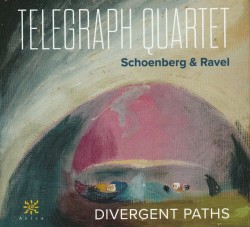 The early 20th century was an exciting time in the development of European concert music, with a plethora of new approaches. With Divergent Paths – Schoenberg & Ravel (Azica ACD-71360 azica.com) the Telegraph Quartet has embarked on a project to present and juxtapose some of these diverse directions. Although born one year apart, Ravel (1875-1937) and Schoenberg (1874-1951) could in many ways not be farther apart, and the same could be said of the quartets presented here, written around the same time (1902 and 1907 respectively). The excellent and extensive liner notes claim that this is the first time the two have been recorded together, and point out that they rarely, if ever, appear on the same concert program. Following in the footsteps of Debussy’s quartet of a decade earlier, Ravel’s is the epitome of French Impressionism while Schoenberg’s expanded tonality points the way to his later development of the 12-note system adopted by the Second Viennese School; together they paint a telling portrait of the changing times. Although there is some sturm und drang in the vif et agité final movement of the Ravel, the overall impression is that of beauty and balance. Schoenberg’s String Quartet No.1 in D Minor, Op.7 starts stormily, in the relative minor key to Ravel’s F Major, making a good case for their pairing, but there the similarities stop. There is a lushness in the Schoenberg, especially in the third movement, but it is a much darker mood than the mostly playful Ravel. Heard now, more than a century after it was composed, the Schoenberg no longer sounds shockingly abrasive and there is even a Romantic sensibility in its quieter moments, making me wonder why it is still so infrequently heard in the concert hall. Fortunately, there are a number of historic recordings available of Schoenberg’s four quartets by the likes of the Juilliard, LaSalle, New Vienna, Schoenberg and Pražák string quartets. Hopefully this committed and thoroughly nuanced performance by the Telegraph Quartet will bring this first to a wider audience. I look forward to where they take us next in their exploration of Divergent Paths.
The early 20th century was an exciting time in the development of European concert music, with a plethora of new approaches. With Divergent Paths – Schoenberg & Ravel (Azica ACD-71360 azica.com) the Telegraph Quartet has embarked on a project to present and juxtapose some of these diverse directions. Although born one year apart, Ravel (1875-1937) and Schoenberg (1874-1951) could in many ways not be farther apart, and the same could be said of the quartets presented here, written around the same time (1902 and 1907 respectively). The excellent and extensive liner notes claim that this is the first time the two have been recorded together, and point out that they rarely, if ever, appear on the same concert program. Following in the footsteps of Debussy’s quartet of a decade earlier, Ravel’s is the epitome of French Impressionism while Schoenberg’s expanded tonality points the way to his later development of the 12-note system adopted by the Second Viennese School; together they paint a telling portrait of the changing times. Although there is some sturm und drang in the vif et agité final movement of the Ravel, the overall impression is that of beauty and balance. Schoenberg’s String Quartet No.1 in D Minor, Op.7 starts stormily, in the relative minor key to Ravel’s F Major, making a good case for their pairing, but there the similarities stop. There is a lushness in the Schoenberg, especially in the third movement, but it is a much darker mood than the mostly playful Ravel. Heard now, more than a century after it was composed, the Schoenberg no longer sounds shockingly abrasive and there is even a Romantic sensibility in its quieter moments, making me wonder why it is still so infrequently heard in the concert hall. Fortunately, there are a number of historic recordings available of Schoenberg’s four quartets by the likes of the Juilliard, LaSalle, New Vienna, Schoenberg and Pražák string quartets. Hopefully this committed and thoroughly nuanced performance by the Telegraph Quartet will bring this first to a wider audience. I look forward to where they take us next in their exploration of Divergent Paths.
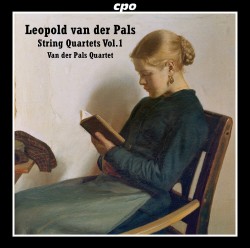 Although relegated to obscurity in recent decades, the prolific composer Leopold van der Pals is currently undergoing a renaissance, thanks in large part to the efforts of cellist Tobias van der Pals, the great-grandson of Leopold’s younger brother, conductor Nikolaj. Leopold was born in St Petersburg in 1884. His father was the Dutch consul there, while his Danish-born maternal grandfather was Julius Johannsen – composer, music theorist, professor at and later director of the St. Petersburg Conservatory. Music had a central role in the van der Pals home, where the composers Glazunov and Tchaikovsky were regular guests, and it was on Glazunov’s recommendation that the young Leopold began his tuition as a composer. At Rachmaninoff’s suggestion he went to study with Reinhold Glière in Berlin, under whose tutelage he completed a symphony that was accepted for performance by the Berlin Philharmonic, an auspicious beginning indeed. The outbreak of WWI forced him to leave Germany and the October Revolution in Russia meant he could not return there either. Van der Pals settled in Switzerland where he remained until his death in 1966.
Although relegated to obscurity in recent decades, the prolific composer Leopold van der Pals is currently undergoing a renaissance, thanks in large part to the efforts of cellist Tobias van der Pals, the great-grandson of Leopold’s younger brother, conductor Nikolaj. Leopold was born in St Petersburg in 1884. His father was the Dutch consul there, while his Danish-born maternal grandfather was Julius Johannsen – composer, music theorist, professor at and later director of the St. Petersburg Conservatory. Music had a central role in the van der Pals home, where the composers Glazunov and Tchaikovsky were regular guests, and it was on Glazunov’s recommendation that the young Leopold began his tuition as a composer. At Rachmaninoff’s suggestion he went to study with Reinhold Glière in Berlin, under whose tutelage he completed a symphony that was accepted for performance by the Berlin Philharmonic, an auspicious beginning indeed. The outbreak of WWI forced him to leave Germany and the October Revolution in Russia meant he could not return there either. Van der Pals settled in Switzerland where he remained until his death in 1966.
Tobias van der Pals has been immersed in his great uncle’s life and legacy for more than 20 years and in 2018 had the opportunity to move Leopold’s entire archive to Copenhagen. There are now over 700 compositions being prepared for publication by Edition Wilhelm Hansen with Tobias as editor. Following a CD of orchestral works and another of solo concertos, CPO has recently released Leopold van der Pals – String Quartets Vol.1 performed by the Van Der Pals Quartet, of which Tobias is a member (CPO 555 282-2 vanderpalsquartet.com). Van der Pals completed six quartets and the first three are included here, along with a brief late work, In Memoriam Marie Steiner. Born a decade after Ravel and Schoenberg, he too wrote his first quartet around the age of 30, beginning it shortly after his move to Switzerland. That decade seems to have made a difference in the confluence of styles, and in van der Pals’ writing we see something of a blending of the cultural differences of the elder masters.
Although van der Pals returned to the medium at several points in his life, the first three quartets were completed within a span of a dozen years. Strangely he didn’t publish the second and only heard a fragment of it performed in his lifetime. It was given its world premiere by this ensemble in 2018. The lyrical third quartet dates from 1929 and was very well received by public and critics alike as, it seems, was all his music. This makes its disappearance during the latter part of the century even harder to fathom. Kudos to Tobias van der Pals and his colleagues and to the folks at CPO for bringing these forgotten gems to light. I am eager to hear more.
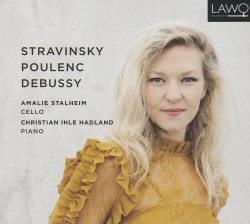 I had hoped to include one more disc, but I see I have run out of space so I will just give it honourable mention here. Stravinsky | Poulenc | Debussy (LAWO Classics LWC1260 lawo.no) features excellent performances by Norwegian cellist Amalie Stalheim and pianist Christian Ihle Hadland of Stravinsky’s Suite Italienne, an arrangement of Baroque-inspired dances extracted from his ballet Pulcinella, and cello sonatas by Poulenc and Debussy, the latter being one of the Impressionist master’s final works. A collection to treasure, with immaculate sound, balance and ensemble playing.
I had hoped to include one more disc, but I see I have run out of space so I will just give it honourable mention here. Stravinsky | Poulenc | Debussy (LAWO Classics LWC1260 lawo.no) features excellent performances by Norwegian cellist Amalie Stalheim and pianist Christian Ihle Hadland of Stravinsky’s Suite Italienne, an arrangement of Baroque-inspired dances extracted from his ballet Pulcinella, and cello sonatas by Poulenc and Debussy, the latter being one of the Impressionist master’s final works. A collection to treasure, with immaculate sound, balance and ensemble playing.
We invite submissions. CDs, DVDs and comments should be sent to: DISCoveries, The WholeNote c/o Music Alive, The Centre for Social Innovation, 720 Bathurst St. Toronto ON M5S 2R4 or to discoveries@thewholenote.com.


